Learn to make sourdough bread recipe easily. This guide shows you how to make artisan sourdough bread in just 25 minutes. You don’t need autolyse. It’s perfect for beginners and uses simple ingredients like flour, water, starter, and salt.
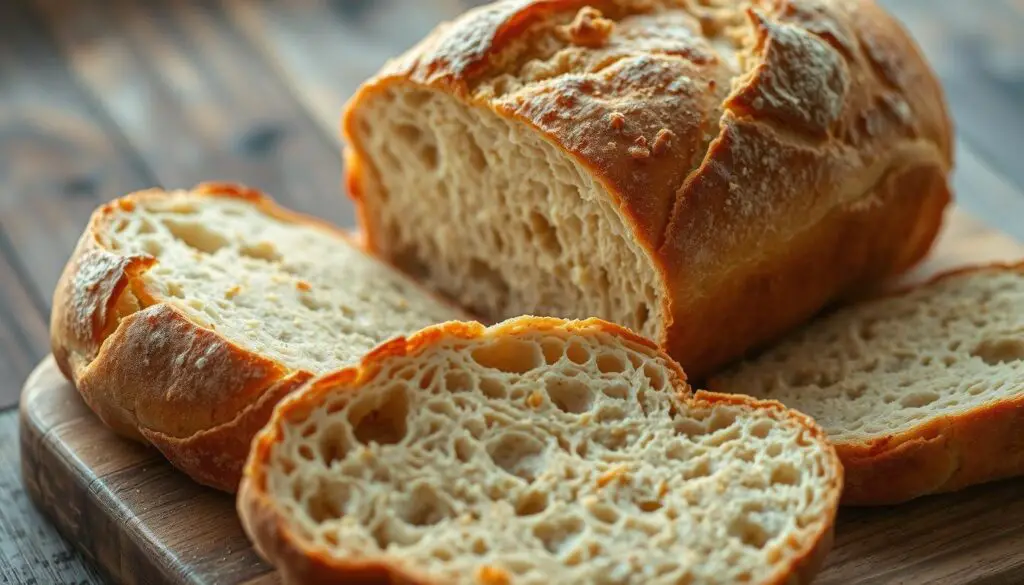
This homemade sourdough method is based on 13 years of baking. It’s simple yet rewarding. The recipe skips preferment and focuses on a quick 5-minute mix. It rises to double its size.
Millions of people view this recipe every month. You don’t need fancy equipment to make it work.
Start by nurturing a starter in a week. Then, shape your loaves and bake at 450°F for a crispy crust. This guide explains every step, from fermentation science to avoiding over-fermentation. Ready to bake bread that stays fresh for two weeks? Let’s begin!
The Magic of Homemade Sourdough Bread
Sourdough’s comeback shows a love for traditional bread making. It mixes old ways with new kitchen ideas. This bread is more than food; it’s a tale of culture, science, and health.
Why Sourdough Has Captured America’s Heart
Homemade sourdough’s popularity is no fluke. Its tangy taste and chewy texture beat out store-bought bread. Bakers love the challenge of making a best sourdough recipe with patience and love. It’s a 6,000-year-old tradition that still delights us today.
The Science Behind Those Beautiful Bubbles
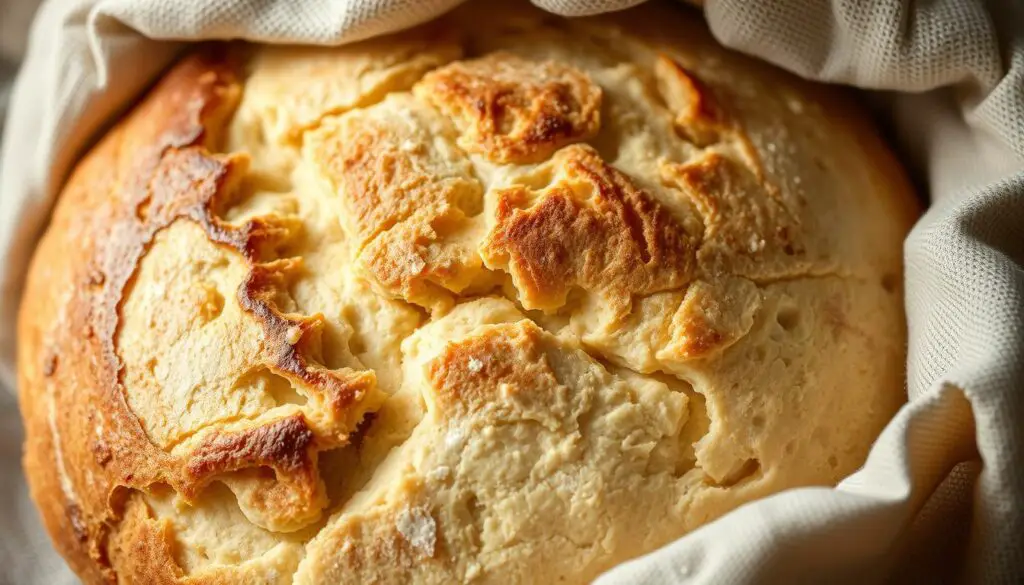
Those holes in the bread come from wild yeast and lactic acid bacteria. Here’s the science:
- Wild yeast eats flour, making CO2 bubbles.
- Lactic acid bacteria add flavor and break down gluten.
- Fermentation for 18–24 hours makes the bread light and easy to digest.
“The longer the fermentation, the more nutrients become available to the body.” — The Bread Baker’s Apprentice
Health Benefits of Naturally Fermented Bread
Naturally fermented sourdough is more than tasty. The 18–24 hour process breaks down harmful acids, making minerals like iron and zinc easier to absorb. It has a lower glycemic index than commercial bread, which is better for blood sugar.
Even people with gluten sensitivities can often eat it. This is because enzymes break down gluten proteins. Each slice has 133 calories, 4.8g protein, and B vitamins like folate. It’s a healthy choice that honors ancient bread-making traditions.
What You’ll Need: Equipment Essentials
Starting with sourdough requires the right tools. These basics and upgrades will help you on your baking journey. Follow these sourdough baking tips to get everything you need for your first loaf.
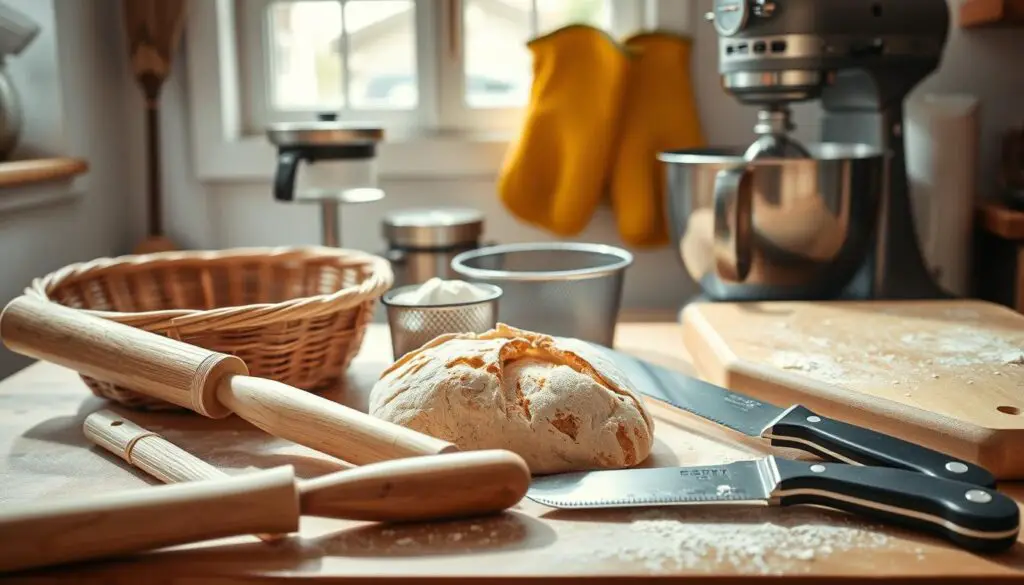
| Essential Item | Purpose | Recommendation |
|---|---|---|
| Digital Kitchen Scale | Ensures precise flour/water ratios | Escali Primo ($20) for accuracy |
| Bread Flour | Builds gluten structure for airy crumb | King Arthur Unbleached ($5/bag) |
| Clear Mixing Bowl | Monitor dough rise during fermentation | 4-Qt Cambro Container ($24/set) |
| Bench Scraper | Efficiently divide and shape dough | OXO Stainless ($10) for durability |
Optional upgrades like a step-by-step sourdough guide can improve your baking:
- Lodge Dutch Oven: Creates oven steam ($39) for crisp crust
- Banneton Basket: Holds shaped dough during proofing (8–10″ diameter)
- Razor Blade: Sharp tool for scoring dough (included in bread lame kits)
- Cooling Rack: Prevents soggy bottoms after baking
Begin with the basics like a scale and bowl. Add tools like a Dutch oven for a better crust as you progress. Even simple items like kitchen towels or plastic wrap can help. Focus on accuracy early on—it will save you trouble later!
Creating Your Sourdough Starter From Scratch
Starting a easy sourdough starter is a rewarding process. It turns flour and water into a bubbly, active culture. Follow this step-by-step sourdough guide to build a reliable starter in 5–9 days. Adjustments may be needed based on your kitchen’s warmth and humidity.
Simple Flour and Water Method
Day 1: Mix 60g whole wheat flour with 60g filtered water. Stir well and cover loosely.
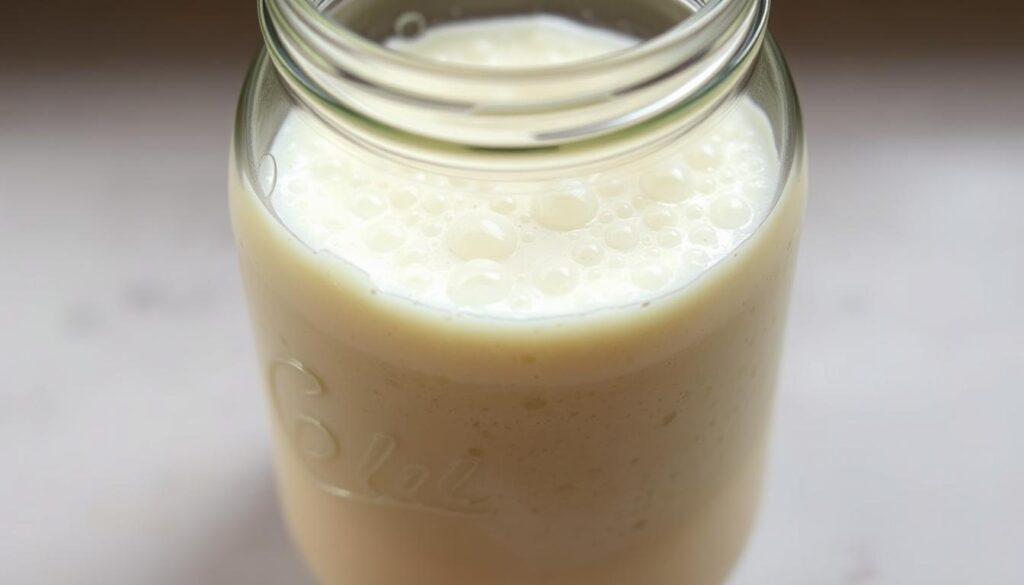
- Days 2–7: Discard half the starter daily. Feed with 60g flour + 60g water. Track volume changes.
- Check for doubling in size within 4–8 hours. If sluggish, increase feedings to twice daily.
- Switch to all-purpose flour after Day 3 for faster activity. Use a jar with 5+ inches headspace.
Signs of a Healthy, Active Starter
- Bubbles forming like champagne foam, especially after feeding.
- A mild sour smell—not overly acidic or vinegary.
- Pass the float test: A teaspoon of starter floats in water when ready.
“A happy starter rises visibly and smells like tangy yogurt, not rotting fruit.”
Troubleshooting Common Starter Problems
Encountering sourdough baking tips for fixes like:
– Hooch (dark liquid): Feed immediately with double the usual flour/water.
– No rise? Move to a warmer spot (70–75°F) and check flour quality (no bromated or bleached flours).
– Mold spots? Discard mold, sanitize jar, and start fresh with clean tools.
Patience is key—your starter will reward consistency. Once active, store in the fridge for long-term use. Happy fermenting!
Understanding Sourdough Fermentation
Fermentation is at the core of every loaf, turning simple ingredients into the airy, tangy artisan sourdough bread. It uses wild yeast and bacteria in flour to ferment sugars. This process creates gas and flavor, thanks to the right mix of time, temperature, and ingredients.
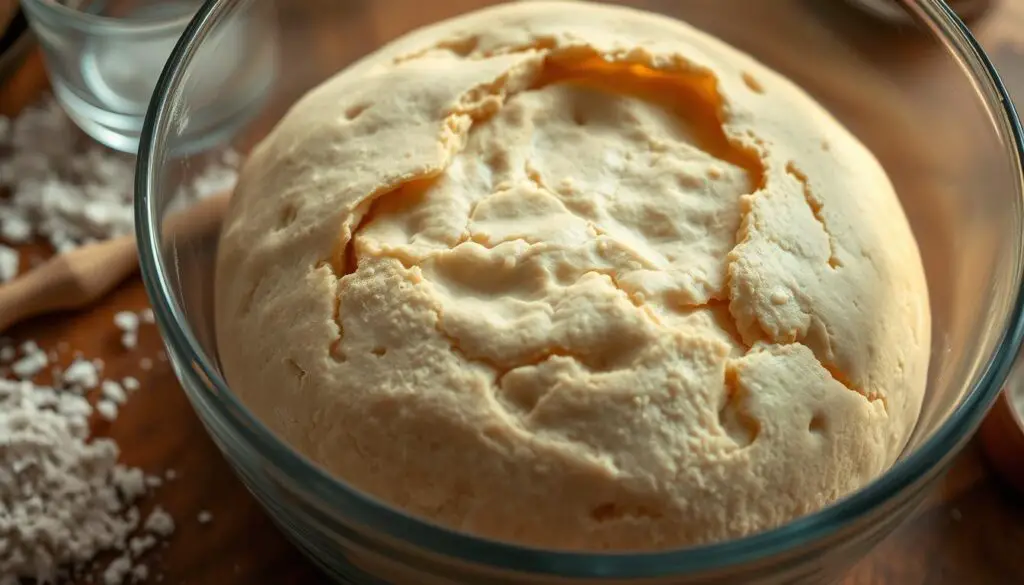
The Role of Wild Yeast and Bacteria
Wild yeast gives the dough its lift. Lactic acid bacteria add the tangy flavor. They work together, feeding on flour’s starches to create carbon dioxide bubbles. This is why sourdough doesn’t need commercial yeast.
Temperature and Time Variables
- Optimal fermentation happens between 74–78°F (23–25°C) for 2–5 hours.
- Cooler temps (38–40°F/3–4°C) slow it down, allowing 4–24-hour cold fermentation.
- Warmer environments (80°F/26°C+) speed it up but risk overactivity—adjust time accordingly.
How Fermentation Affects Flavor Development
A 6-hour ferment at 75% hydration gives mild, sweet notes. Extend it to 12 hours at cooler temps, and the acids deepen into sharp tang. Using whole wheat flour at higher hydration (100%) boosts earthy flavors. These choices let bakers craft their ideal sourdough bread recipe—whether mellow or boldly flavored.
Sourdough Bread Recipe: The Basic Master Formula
Learning the sourdough bread recipe begins here. This best sourdough recipe makes a organic sourdough loaf with a crunchy crust and light inside. Use exact amounts for the best results:
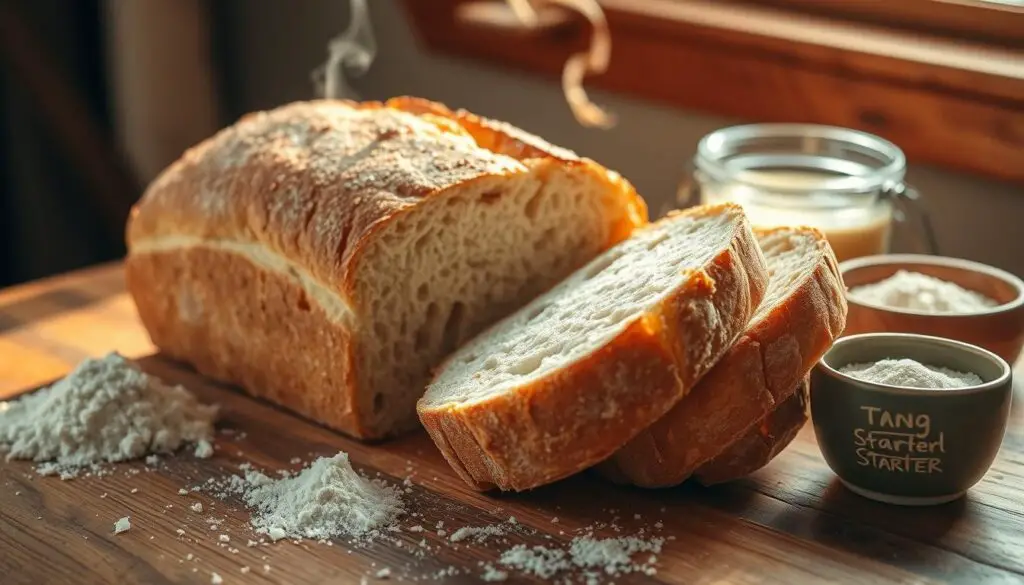
- Ingredients (makes two loaves):
- 500g bread flour (King Arthur or Bob’s Red Mill)
- 10g fine sea salt
- 375g warm water (75°F/24°C)
- 50-100g active sourdough starter (100% hydration)
Start with a 72% hydration dough. Use 80% Artisan Bread Flour, 15% Whole Wheat, and 5% Rye for rich flavors. The starter adds 7.5% pre-fermented flour, boosting sourness and shelf life. Here’s how to start:
- Mix flour, water, and 50g starter into a shaggy dough.
- Autolyse for 1 hour to develop gluten naturally.
- Add salt and 190g levain (made by feeding 38g starter with equal parts flour/water 5-6 hours prior).
“The float test confirms starter readiness: a spoonful floating means it’s ready to bake!”
Adjust hydration by ±5% for softer or denser crumb. For an organic sourdough loaf, choose Bob’s Red Mill Organic flours. Total time is 19 hours, including 4-hour bulk fermentation with 3 stretch-and-fold sessions. Track progress by a 20-50% dough rise before shaping.
Pro tip: Reserve 50g water for final mix adjustments. Use a Dutch oven for even steam during baking. This formula balances science and flexibility—your starter’s activity and kitchen temp will influence timing slightly. Now you’re ready to move to mixing and kneading in the next steps.
Mixing and Developing Your Dough
Mastering dough development is key to creating homemade sourdough with a light, airy crumb. This step-by-step sourdough guide breaks down techniques to build gluten structure without overcomplicating the process. Start by combining starter, water, and flour as instructed, then follow these foundational steps.
Autolyse Method for Better Structure
Start with the autolyse phase: mix flour and water (without salt or starter) for 30–60 minutes. This resting period softens gluten strands, reducing mixing time by up to 30%. A 30-minute autolyse cuts hand mixing by 50%, making dough easier to handle.
Overhydration risks? Use the bassinage technique—mix half the flour with liquid first to avoid a “soupy” mess.
Hand Kneading vs. Stretch and Fold
- Stretch and Fold: Ideal for high-hydration doughs (70%+). Requires 2–3 intervals every 30 minutes, taking 15–20 minutes total.
- Hand Kneading: Works best for drier doughs. Aim for 5–8 minutes until the dough passes the windowpane test.
Pro tip: Mechanical mixers can handle up to 8kg batches, but home bakers should mix 2 minutes on low + 3–6 on medium to avoid overoxidation. Use the slap-and-fold technique for 2–8 minutes for silky texture.
Reading Your Dough’s Signals
Check dough consistency: if sticky, add 1–2 tbsp flour. If stiff, add 1 tsp water. The sourdough baking tips here ensure success—test gluten strength by stretching a small piece into a translucent “windowpane” without tearing. This homemade sourdough process adapts to your flour type, so trust your hands over a clock!
The Art of Bulk Fermentation
Mastering bulk fermentation is key to making great artisan sourdough bread. This stage, often the longest, builds flavor and structure. It turns dough into a light, bubbly mass ready for shaping.
- Visible air bubbles forming on the surface
- A 30-40% volume increase
- A poke test where the indentation stays but slowly springs back
Sourdough baking tips for success:
- Keep dough at 68–70°F; warmer temps speed up fermentation.
- Perform 3–4 sets of stretch-and-folds every 30 minutes during the first half of fermentation.
- Adjust timing: 4–5 hours at 78–80°F or extend to 10–48 hours in the fridge for deeper flavor.
Dough that’s over-fermented becomes slack and flat. Under-fermented dough stays stiff. Use a timer and visual checks to avoid mistakes. Cold fermentation slows activity, making it ideal for busy schedules.
This traditional bread making technique balances time and patience. It ensures a flavorful crumb and open structure. Perfectly timed bulk fermentation turns simple ingredients into the airy, tangy loaves that define artisan sourdough bread.
Shaping Perfect Artisan Loaves
Learning to shape dough is key to making artisan sourdough bread. The right technique helps your loaf have a high rise, a crisp crust, and an airy inside. We’ll look at two classic shapes.
Boule (Round Loaf) Technique
Start by dusting a clean surface with flour. Use a bench knife to lift and flip the dough. This removes extra flour, making the dough stickier.
Next, fold the top edge toward the center. Rotate the dough 90 degrees each time. Keep folding until the surface is smooth and tight.
Flip the dough again to show the smooth side up. Then, place it seam-down on a floured couche or linen cloth.
Batard (Oval Loaf)
Begin by pinching the top into a diamond shape. Fold the bottom third up, then roll the dough away from you. Use your palms to apply gentle pressure.
Keep rolling until the dough is an elongated oval. Aim for a balanced oval with even tension. Place it in a floured banneton or bowl for proofing.
Building Tension for Oven Spring
- Brush off excess flour to expose the dough’s surface
- Work quickly but gently to avoid over-handling
- Create a taut skin by folding edges inward while rotating
- Test tension by gently poking the dough—if it springs back, it’s ready
Practice makes perfect. Even if your shapes aren’t perfect, you’ll still get delicious best sourdough recipe results. The step-by-step sourdough guide focuses on building tension for that perfect oven spring. Don’t worry if your first loaves aren’t perfect; every fold brings you closer to bakery-quality loaves.
Proofing Your Sourdough: Timing and Techniques
Proofing is the last rise before baking. It shapes your homemade sourdough‘s crumb. Here are some sourdough baking tips for timing and techniques:
- Choose a sourdough bread recipe that fits your kitchen. Room temperature proofing (70–80°F) takes 1–2 hours. Cold proofing (39–46°F) can last 8–16 hours.
- Check if it’s ready with the finger poke test. If it springs back slowly, it’s ready. Quick rebound means it’s not ready yet. No rebound means it’s overproofed.
- Use containers like bannetons or floured bowls. Line them with linen for better grip during baking.
| Temperature (°F) | Proofing Time | Notes |
|---|---|---|
| 80°F (26°C) | 1–2 hours | Best for quick results |
| 74–76°F (23–24°C) | 2–4 hours | Standard room conditions |
| 46°F (8°C) | 6–8 hours | Cold slow development |
| 39°F (4°C) | 10–16 hours | Overnight options |
Cold proofing adds tang and flexibility. For the best sourdough baking tips, refrigerate dough in an airtight container. Overproofing can make the crumb dense, so watch closely. Adjust times based on how wet the dough is—wetter doughs may need shorter proofing.
Mastering proofing ensures your homemade sourdough has the airy crumb and crackling crust you desire. Practice the tests and adapt to your kitchen’s conditions for consistent results.
Scoring Patterns to Enhance Your Bread’s Appearance
After the second rise, and right before baking, a simple slash can transform dough into art.
Scoring is more than just making your bread look good. It’s a sourdough baking tip that helps your loaf grow right. For artisan sourdough bread, shallow cuts (¼ inch) make beautiful designs. Deeper slashes (½ inch) lead to amazing oven spring.
Start with a basic diagonal slash for boules. Or try out geometric patterns for a traditional bread making touch.
Simple Slashes: A single vertical cut ensures even expansion in round loaves. Geometric Patterns: Try a tic-tac-toe grid for batards or leaf shapes for rustic loaves. Freezing Dough: Chill dough 30 minutes before scoring to stabilize its shape.
A sharp bread lame or razor blade is key. Dull tools can mess up your design. Sourdough Fever’s stencils help you get precise cuts. Dusting rice flour on the dough makes your slashes stand out.
Practice on rested dough first. Test your cuts on parchment paper to avoid mistakes. Remember, the depth of your cuts depends on how wet the dough is. By mastering this, you pay homage to traditional bread making while adding your own flair to every loaf.
Baking Methods for the Perfect Crust
Getting the crust right is crucial for any best sourdough recipe. This part explains how to get that perfect crunch and color. We’ll use the sourdough bread recipe steps from this step-by-step sourdough guide. Let’s dive into the methods that make dough turn into golden, crackling perfection.
“The Dutch oven traps moisture, creating steam that lets the bread rise fully before the crust hardens.”
Dutch Oven Baking Technique
First, preheat a pre-seasoned Dutch oven for 45 minutes at 475°F. Score the dough and put it in the pot. Bake covered at 450°F for 20 minutes, then uncover and bake for 25–35 minutes more. The dough should reach 205–210°F inside.
Cast iron keeps the heat even, ensuring your bread bakes perfectly.
Creating Steam in Home Ovens
Don’t have a Dutch oven? Here are some alternatives:
- Place a preheated steam tray on the oven’s bottom rack.
- Spray the oven walls with a plant mister every 10 minutes for the first 15 minutes.
- Use a preheated cast-iron skillet with a lid for extra steam retention.
Temperature and Time Guidelines
Adjust the temperature based on your oven:
| Method | Temperature | Time |
|---|---|---|
| Dutch oven | 475°F (245°C) | 20 min covered / 25–35 min uncovered |
| Steam tray | 450°F (230°C) | 30–40 min total with misting |
| Cooking without steam | 425°F (218°C) | 45–60 min, monitor closely |
For thicker crusts, use lower temperatures (425°F) and longer baking times. Aim for an internal temperature of 205–210°F to avoid a soggy center.
Recognizing When Your Bread Is Done
Learning to bake sourdough starts with knowing when to take it out of the oven. The best way is to check the internal temperature. Aim for 205–210°F (96–98°C). This method ensures your organic sourdough loaf is perfectly baked.
Use an instant-read thermometer to check the center. Make sure not to hit the bottom crust. This way, you avoid mistakes.
- Temperature: 205–210°F (96–98°C) guarantees doneness. Over 212°F risks burning.
- Sound: Tap the loaf’s bottom. A hollow drum-like ring means it’s ready.
- Color: Look for deep golden to mahogany tones. Sourdough’s crust can brown darker than expected without burning.
- Weight loss: A 15% reduction signals moisture loss is complete.
For organic sourdough loaf made with whole grains or rye, allow extra time. Their denser structure may need 5–10 extra minutes. Don’t just look at the color—especially with high-hydration doughs.
The step-by-step sourdough guide teaches patience. Underbaked loaves stay gummy, while overbaked ones lose moisture.
“The oven is done when the bread speaks to you. Listen closely.”
After taking the loaf out of the oven, let it cool completely on a rack. Don’t slice it right away—the crumb will firm up as it cools. Keep track of your thermometer readings and color notes in your baking journal. With time, these sourdough baking tips will become second nature. Remember, each bake teaches you something new!
Cooling and Storing Your Sourdough Loaves
Patience is key for perfect sourdough texture. Let the bread cool on a rack for at least an hour. Slicing too soon can make it gummy.
This step is crucial for keeping your sourdough fresh.
Sourdough bread can remain edible for a week or more without chemical preservatives. — WSU Bread Lab
Why Patience Matters After Baking
Warm bread stays hot longer than you think. Moisture inside makes the gluten soft, leading to soggy centers. Wait until it reaches room temperature, usually 1.5–2 hours for large loaves.
This lets starch molecules set right, keeping the crumb airy.
Preservation Methods for Freshness
Choosing how to store your bread depends on what you value most. For crusty loaves like organic sourdough loaf, try these:
- Room Temp: Wrap in beeswax wraps for 3–5 days. Avoid plastic at first—it traps moisture if the bread isn’t fully cooled.
- Freezing: Slice first. Place between parchment layers in airtight bags. Reheat frozen slices in a Breville Smart Toaster for fresh texture.
- Refrigeration: Only use for 1–2 days. Cold air dries it out faster, but works well for softer sandwich loaves.
Whole grain sourdough stays fresh longer because starch breaks down slower. For long-term storage:
- Wrap cooled loaves tightly in parchment and freezer bags.
- Freeze in labeled bags for up to 3 months.
- To revive frozen bread, steam reheat in a 350°F oven.
Always store cut sides down to reduce exposure. With these steps, your organic sourdough loaf stays delicious longer—no preservatives needed!
Troubleshooting Common Sourdough Problems
Even experienced bakers face challenges. These sourdough baking tips turn mistakes into learning experiences. Mastering the step-by-step sourdough guide requires practice. But knowing why issues occur makes fixing them easier. Let’s explore solutions for common problems.
“The most common mistake I see people make when making sourdough bread is letting the bulk fermentation go too long. They mix the dough at night; then wake up to dough that’s a sticky mess.” – Expert Baker
Problem 1: Dense or Gummy Crumb
Over-fermented dough often leads to a dense crumb. Here are some fixes:
- Check bulk fermentation stops when dough rises 50%, not tripled
- Use a kitchen scale (
- Ensure starter is mature (14+ days old) for proper leavening
Problem 2: Flat Loaves
- Under-proofed dough won’t rise – proof until dough holds an indentation for 2-3 seconds
- Preheat Dutch ovens to 500°F first 20 mins, then lower to 450°F
- Check starter’s activity – weak starters need feeding 8-12 hours before baking
Problem 3: Unusual Flavors or Mold
- Mold spots mean improper storage – cool loaves fully (2 hours) before wrapping in paper bags
- Overly sour bread? Reduce bulk fermentation time to keep acidity lower
- For gummy interiors, bake until internal temp hits 208°F – don’t rush the final rise
Remember: A sourdough bread recipe succeeds through consistency. Adjust flour types (King Arthur brands work well) and track fermentation times. If dough spreads during scoring, it’s under-tensioned – revisit shaping techniques. Every failed loaf teaches you how to refine your process. Keep experimenting!
Conclusion: Your Journey to Sourdough Mastery
Sourdough baking is more than just a recipe. It connects you to traditional bread making that’s over 6,000 years old. Your journey begins with an easy sourdough starter that turns simple flour and water into something alive. Each step, from rising to baking, links you to bakers from past generations.
Start with the basics from this guide. Then, try new things like making an organic sourdough loaf with whole wheat or spelt. Keep a journal to track your progress. Note how changes in water or fermentation time affect your bread’s taste and texture.
Join online communities to share tips and learn from others. You might find new ideas for shapes or flavors, like rosemary focaccia or multigrain loaves.
Remember, a 30-gram starter and 85% hydration dough are just the start. Try baking at 450°F, using steam, or letting your dough rest overnight. Each loaf teaches you something new, like the perfect crust or a tangy flavor from longer fermentation.
Sourdough’s science is exact, but its heart is in the handmade touch. Don’t be afraid of mistakes. Share your successes and keep your starter happy with regular feedings. This ancient craft rewards your effort, turning simple ingredients into something truly personal. Your next loaf could be the best one yet—so get ready to bake and explore.
FAQ
What equipment do I need to start baking sourdough bread?
You’ll need a digital scale for precise measurements. A Dutch oven or covered baking vessel is key for steam. You’ll also need mixing bowls, bench scrapers, bannetons, scoring tools, and a thermometer.
Most of these items are easy to find and fit various budgets.
How can I tell if my sourdough starter is healthy?
Look for bubbles and a rise in volume after feeding. It should smell tangy and have a thick, pourable texture. The float test is also a good indicator.
If a starter piece floats in water, it’s ready to use.
What’s the best way to achieve a crusty exterior on my sourdough bread?
Baking in a Dutch oven is best for a crispy crust. If you don’t have one, use a tray of water or a steam pan in your oven. These can also create the needed humidity.
Why is sourdough bread better for digestion compared to commercial bread?
Sourdough’s fermentation makes nutrients more available. It reduces gluten and has a lower glycemic index. This makes it easier to digest, especially for those with mild gluten sensitivities.
How do I know when my bread is fully baked?
It should have a deep golden to dark brown crust. It should sound hollow when tapped and have an internal temperature of 205-210°F (96-98°C).
Can I make adjustments to the sourdough recipe for different flours?
Yes! You can use whole grain flours or adjust hydration levels. The recipe is flexible to suit your taste and the flour’s characteristics.
What should I do if my dough doesn’t rise properly?
It might be due to underfermentation, an inactive starter, or wrong shaping. Check your dough’s temperature and timing. If it’s not rising, try feeding your starter more or extend fermentation time.
How long should I let my bread cool before slicing?
Let it cool for at least one hour after baking. This helps the crumb set and prevents a gummy texture when sliced.
How should I store my sourdough bread to maintain freshness?
Store it in a bread box or wrapped in cloth to keep the crust. Beeswax wraps are a good eco-friendly option. For longer storage, freeze it—slice before freezing for easy toasting.
What are some common mistakes to avoid while baking sourdough?
Avoid skipping fermentation, ignoring dough hydration, and improper shaping. Keeping a baking journal helps track your progress and identify issues.